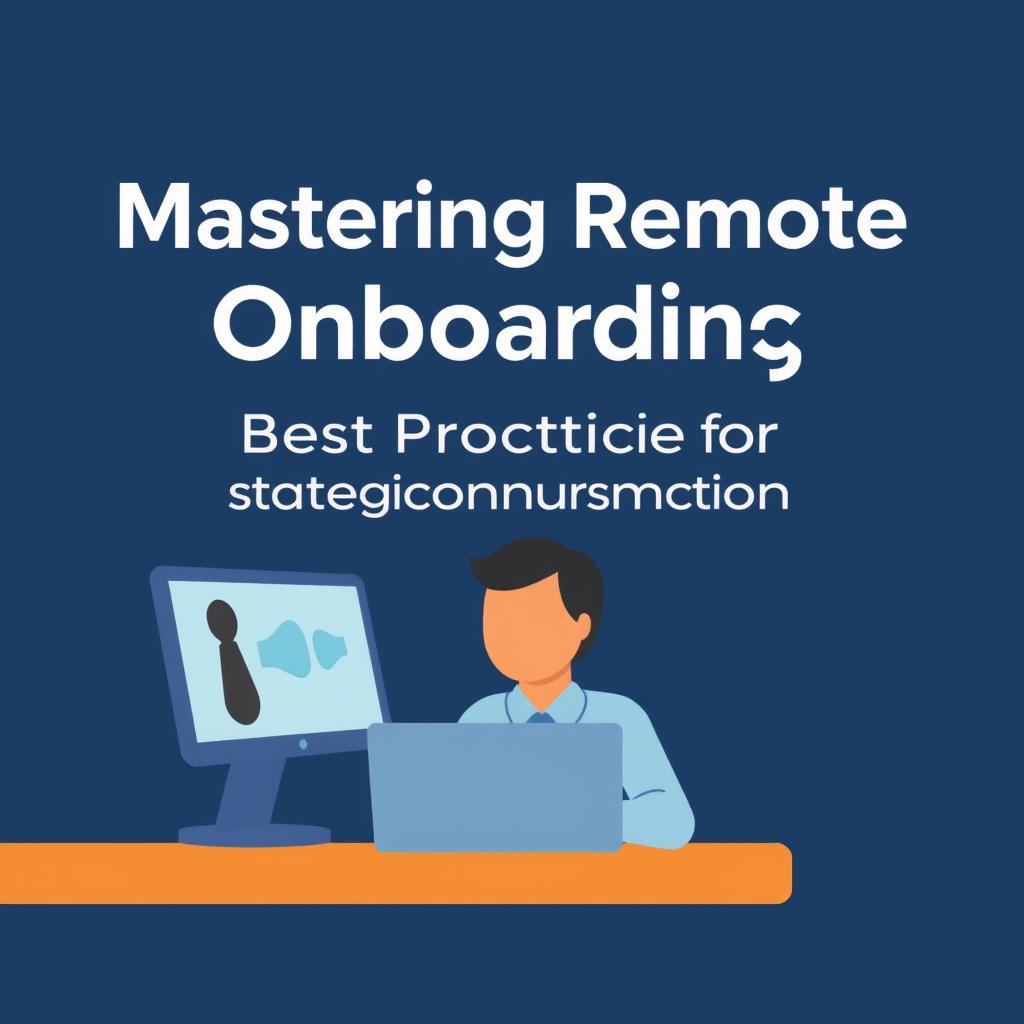Mastering Remote Onboarding: Best Practices for Strategic Communication
Estimated reading time: 7 minutes
- Effective communication sets the tone for successful remote onboarding.
- Structured onboarding plans can significantly enhance new hire integration.
- Regular check-ins help build relationships and ensure continuous feedback.
- Leverage technology for better engagement and task management.
- Define clear communication standards to streamline interactions.
Table of Contents
Introduction
In today’s fast-paced digital landscape, the method by which companies onboard new employees can often make or break their integration into the workforce. As organizations transition towards remote operations, creating a strategic communication plan has become critical. Onboarding is no longer merely a formality; it’s a pivotal experience that can enhance employee satisfaction, boost retention rates, and set the tone for success. Yet, despite its importance, many companies face challenges such as information overload, insufficient support, and ineffective communication.
But why is effective communication in onboarding so vital? The answer lies in the ripple effect it has on new hires. When properly executed, an onboarding process not only ensures that new employees understand their roles but also fosters a sense of belonging. It establishes company culture, sets expectations, and anchors them within their teams. Conversely, failure to provide a structured onboarding experience can lead to disengagement, lowered morale, and ultimately, increased turnover.
Yet, many businesses struggle with fundamental aspects of remote onboarding. Common hurdles include miscommunication, technology mishaps, and inadequate feedback mechanisms, all of which can leave new employees feeling isolated, overwhelmed, and unprepared. So, how can we confront these challenges head-on? The solution lies in implementing best practices that consider the unique challenges of the remote workspace while fortifying clear and consistent communication.
This blog post will dive deep into those best practices, offering actionable strategies that businesses can adopt to ensure a smooth and successful onboarding experience. Whether you’re a team leader, HR professional, or even a new hire looking to navigate your first few weeks, the following insights will shed light on how structured communication can transform the onboarding process.
Professionalizeitto.me is here to help you refine your communication skills, ensuring that your onboarding processes are effective, insightful, and tailored to your organization’s culture. Let’s explore how to do just that.
Examples and Templates
1. Clear Communication Channels
Best Practice: Establish dedicated channels for different types of communication. Utilizing tools like Slack or Microsoft Teams can streamline daily updates, while emails can serve for formal announcements. Video conferencing, on the other hand, facilitates essential face-to-face interactions.
Actionable Strategies:
- Create Dedicated Channels: Implement specific channels for onboarding-related questions, such as
#newhire-questionsto keep conversations organized. - Use Naming Conventions: Adopt clear naming conventions for channels (e.g.,
#team-marketing,#project-alpha) to eliminate ambiguity. - Formulate Guidelines: Establish clear usage guidelines to define expected response times and content types.
Real-World Example: Automattic, a completely distributed company, uses Slack effectively, ensuring distinct channels for teams and projects.
Challenges & Solutions:
- Challenge: Information overload can result from too many communication channels.
- Solution: Regularly audit and archive inactive channels. Encourage the use of threads to keep discussions focused.
2. Structured Onboarding Plan
Best Practice: A detailed onboarding plan should outline the first few weeks—training sessions, introductions to team members, and specific goals are key components.
Actionable Strategies:
- 30-60-90 Day Plan: Draft a comprehensive plan that specifies key milestones and expectations.
- Onboarding Schedule: Create a detailed schedule clarifying activities and deadline timelines.
- Assign an Onboarding Buddy: Pair the new hire with an experienced employee to navigate the onboarding process together.
Real-World Example: Google employs a “Noogler” system that assigns experienced employees to assist new hires, fostering support and guidance.
Challenges & Solutions:
- Challenge: New hires may feel overwhelmed.
- Solution: Break the onboarding plan into manageable chunks and centralize resources for easy access.
3. Leverage Technology
Best Practice: Use video conferencing tools for personal interactions, instant messaging for quick queries, and project management platforms for task tracking.
Actionable Strategies:
- Implement Video Conferencing: Utilize Zoom for team introductions and individual check-ins.
- Project Management Tools: Harness platforms like Asana or Trello for tracking tasks and deadlines.
- Provide Technical Training: Ensure new hires receive training on the necessary technology stack.
Real-World Example: Zapier effectively combines Slack, Zoom, and Trello for seamless team collaboration.
Challenges & Solutions:
- Challenge: Technological glitches can disrupt onboarding.
- Solution: Offer comprehensive tech support, ensuring all new hires have necessary tools from their first day.
4. Regular Check-Ins
Best Practice: Schedule consistent one-on-one meetings between new hires and their managers to foster communication.
Actionable Strategies:
- Consistent Check-Ins: Organize weekly or bi-weekly meetings for the first few months.
- Structured Agendas: Use an agenda to guide conversations and ensure productive discussions.
- Create Safe Spaces: Promote open communication, reassuring new hires that their inquiries are welcome and valued.
Real-World Example: Buffer prioritizes regular one-on-one meetings and frequent check-ins as essential components of their onboarding process.
Challenges & Solutions:
- Challenge: Establishing rapport in a virtual environment can be difficult.
- Solution: Utilize video conferencing and strive to connect on a personal level to cultivate trust.
5. Feedback Mechanisms
Best Practice: Implement multiple feedback channels such as surveys, one-on-one meetings, and group discussions to gain insights and enhance the onboarding process.
Actionable Strategies:
- Conduct Surveys: Distribute anonymous onboarding surveys at key intervals (e.g., after one week, one month, and three months).
- Informal Feedback Sessions: Schedule feedback discussions during regular check-ins.
- Create Feedback Channels: Develop dedicated channels where new employees can share insights and critiques.
Real-World Example: Netflix effectively utilizes continuous feedback to refine its onboarding processes.
Challenges & Solutions:
- Challenge: New hires may hesitate to share candid feedback.
- Solution: Assure anonymity in surveys and foster an open communication culture appreciating honest input.
6. Tech Setup Assistance
Best Practice: Offer robust support for tech setup, guaranteeing access to essential tools from the first day.
Actionable Strategies:
- Tech Setup Checklist: Send a checklist detailing items needed for day-one tech setup.
- Remote IT Support: Ensure accessible tech support to resolve any setup issues promptly.
- Training on Technology: Provide training on using the technology stack to enhance proficiency.
Real-World Example: Various organizations create dedicated IT support channels for swift issue resolution.
Challenges & Solutions:
- Challenge: Technical problems may delay onboarding.
- Solution: Address potential issues with comprehensive instructions and readily available assistance.
7. Define Communication Standards
Best Practice: Establish clear protocols for communication, including expected response times and favored channels to streamline interactions.
Actionable Strategies:
- Create a Communication Guide: Detail preferred channels for different communication types.
- Set Response Expectations: Define typical response times and encourage the use of asynchronous tools where appropriate.
- Encourage Video Conferencing: Promote the use of video conferencing for significant discussions to convey clarity beyond words.
Real-World Example: GitLab has a comprehensive communication guide outlining best practices for remote communication.
Challenges & Solutions:
- Challenge: Misunderstanding may arise in text-based communication without non-verbal cues.
- Solution: Promote video conferencing for crucial discussions and provide training to enhance virtual communication skills.
By proactively implementing these best practices, organizations can address challenges and create a seamless and engaging remote onboarding experience that fosters a sense of belonging. Not only does this initiative boost retention and productivity, but it also solidifies the foundation for a successful and cohesive team.
Call to Action
Now that we’ve explored the essential elements of effective remote onboarding and the best practices to implement, it’s time to elevate your communication strategy. At professionalizeitto.me, we provide tailored resources and insights to enhance your communication skills, ensuring you can execute these best practices with confidence and clarity.
How to Get Started:
- Subscribe to Our Newsletter: Stay updated with the latest tips and tools in professional communication.
- Book a Consultation: Gain personalized insights tailored to your organization’s needs from our experts.
- Explore Premium Resources: Access exclusive templates and guides that take your written communication to the next level.
Don’t let poor communication hinder your team’s success. Visit professionalizeitto.me today and give your onboarding process the professional edge it deserves. By mastering these strategies, not only can you improve your remote onboarding experience, but you also pave the way for ongoing success in your organization.
FAQ
What are the benefits of remote onboarding?
Remote onboarding improves employee satisfaction, retention, and integration into the company culture.
How can I ensure effective communication during remote onboarding?
By establishing clear communication channels, regular check-ins, and using collaborative technologies.
What tools should I use for remote onboarding?
Consider using tools like Slack, Zoom, Asana, or Trello to facilitate communication and task management.
How often should new hires be checked in on?
It’s recommended to have weekly or bi-weekly check-ins for the first few months.
What should be included in an onboarding plan?
An onboarding plan should include training sessions, introductions, goals, and support resources.



